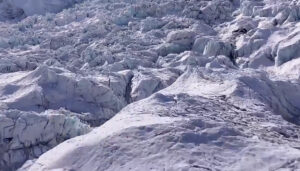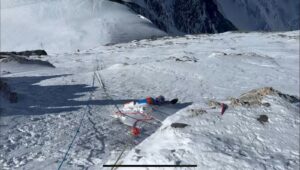Before the first ascent of Everest on May 29, 1953, there had been 14 (or maybe 15) attempts to ascend the highest peak in the world. The best known is the 1924 attempt when Andrew Irvine and George Mallory disappeared. But the climbing stories of the other attempts are very interesting too, with lots of exciting micro-stories within each climb.

Everest’s north face from the path to Base Camp, Tibet (5,160m). Photo: Luca Galuzzi
The British target Everest
At the end of the 19th century, British organizations like the Royal Geographical Society (RGS) and the Alpine Club had been working out how to send a scouting expedition to Everest. Among those who most promoted the idea were Sir Francis Younghusband and Charles Bruce. However, the British had trouble obtaining permission because of complicated political and diplomatic reasons.
British Army officer John Noel illegally entered Tibet in 1913 but only made it within 70km of Everest. In 1919, explorer Charles Howard-Bury addressed a letter to the RGS suggesting a reconnaissance expedition. Howard-Bury intended to reach Everest’s summit, but the Indian Office rejected his proposal.
In 1920, Howard-Bury visited India and entered Tibet, where he met British political officer Charles Bell. Bell had good contacts in Tibet and visited the Dalai Lama later in 1920. After their discussion, the Dalai Lama promised to grant permission for the British to send an expedition to Everest.
The RGS and the Alpine Club established the Everest Committee with Younghusband as chairperson. A reconnaissance expedition to Everest started to form. Although the main objective was reconnaissance, it didn’t mean that a climb couldn’t take place.

Charles Howard-Bury (seated second from right) with other members of the 1921 Everest expedition. Photo: Marian Keaney
The Howard-Bury expedition, 1921
In 1921, a reconnaissance expedition was finally launched under the leadership of Howard-Bury. The team consisted of eight British men, one Canadian, and a group of porters. Among the team members were George Mallory and Alexander Kellas. The group approached Everest via Sikkim-Chumbi Valley, entering Tibet.
British mountaineer, chemist, and explorer Alexander Kellas had been investigating high-altitude physiology to see whether the human body could adapt to high altitudes. With great prescience, he concluded that in the future, it would be possible to climb Everest without bottled oxygen. However, Kellas advocated for the team to use oxygen.
Kellas never made it to Everest. During the approach trek, he died of a heart attack in the village of Kampa Dzong. He could be considered Everest’s first climbing fatality. Later, an Indian porter also died during the approach.
The team explored the west, north, and east sides of Everest during an expedition that lasted 96 days. Two of the climbers, Guy Bullock and George Mallory, reached the North Col at 7,020m without bottled oxygen.
Some strange footprints were detected at high altitudes. Howard-Bury suggested that they might be from a large grey wolf, but the sherpas insisted that the footprints were from a “metch kangmi” (filthy snowman). Likely the result of a later mistranslation, the expression became the “abominable snowman.”
The bold 1922 attempt and a fatality
The British went to Everest again in the spring of 1922, led by Brigadier-General Charles Bruce. Bruce was a former boxer and had also represented England years before in an international running competition. He had broad experience in the highest mountains of Asia too. Before 1922, Bruce had been on expeditions to the Karakoram, Nanga Parbat, and Trisul.
A member of the Indian Army, Bruce was fluent in the Nepali language. He introduced his Ghurkas to hill racing and he took the best of them to Zermatt in the Alps to learn ice climbing.
Bruce’s 1922 team included Tom Longstaff, Edward Norton, Howard Somervell, and George Mallory. The group made an attempt from the Tibetan side of Everest. Bruce and Australian George Ingle Finch reached 8,326m with bottled oxygen. But, exhausted, they could not progress further because of problems with their O2 cylinders. Far worse, an avalanche killed seven sherpas below the North Col.

View of Everest from the Rongbuk Valley, close to Base Camp and the terminus of the Rongbuk Glacier at 5,200m. Photo: Wikimedia
Mallory and Irvine’s 1924 disappearance
The best-known attempt was in the spring of 1924. There is a lot of literature written on this expedition. The British team, under the leadership of Edward Norton, tried to ascend from the north. The route they chose had been suggested by Mallory in 1921: Rongbuk Glacier-North Col-North Ridge-Northeast Ridge-summit.
In small groups, they made three attempts. The first two went without bottled oxygen.
The first attempt, made by George Mallory and Geoffrey Bruce, couldn’t reach Camp 6 at 8,200m.
Edward Norton and Howard Somervell made the second attempt. After Somervell retreated, Norton made it higher than anyone before him, reaching an astonishing 8,573m without bottled oxygen.

The Three Steps are three prominent rocky steps on the Northeast Ridge of Everest. The First Step is at 8,564m, the Second Step is at 8,610m, and the Third Step is at 8,710m. Odell likely saw Mallory and Irvine on the Second Step before they disappeared. Photo: Wikipedia
The third attempt was carried out by George Mallory and Andrew Irvine with bottled oxygen. The pair was last seen at about 8,600m, on the northeast ridge, before they disappeared. Mallory’s body was found in May 1999, at 8,155m.
Some people think that they summited Everest, but this is unconfirmed. Their camera has never been found.

The last photo of George Mallory and Andrew Irvine at Base Camp before starting their ascent. Photo: Noel Odell
Ruttledge’s 1933 attempt
Hugh Ruttledge led a team featuring British and Indian climbers, as well as a group of sherpas, to the north side of Everest in the spring of 1933. The group reached 8,570m without supplementary oxygen before they retreated because of the difficulty of the route.
Maurice Wilson in 1934
A God-fearing man, Maurice Wilson was full of self-confidence but had very little climbing experience. With rubbish equipment, he tried to climb Everest alone, from the north.
At the start of his expedition, he was accompanied by two sherpas, but they later left. The sherpas correctly observed that Wilson’s idea was too ambitious and dangerous. But Wilson continued alone, believing that faith alone would help him reach the summit.
Wilson died at 6,500m of exposure. His body was found one year later. In his diary, found beside his body, the last entry was: “Off again. Gorgeous day.”

The 1934 diary of Maurice Wilson. Photo: Shutterstock
Eric Shipton’s 1935 attempt
Renowned alpinist and explorer Eric Shipton led a team to the north side of Everest in the summer of 1935. Among the team members were Harold William Tilman and Tenzing Norgay. Bad conditions made them retreat from around 7,000m on the north side, without supplementary oxygen. They also made a reconnaissance of the west side of Everest.
1936 to 1951: A handful of attempts but no summits
In the spring of 1936, Hugh Ruttledge returned to Everest and reached 7,000m without bottled oxygen. Bad weather meant the team did not continue higher.
In 1938, Bill Tilman’s team reached 8,300m on O2, where they had to give up because of deep snow.
In 1947, Canadian engineer Earl Denman, together with Tenzing Norgay and Ang Dawa Sherpa, entered Tibet illegally to attempt to Everest from the north. A strong storm hit, and they only reached 6,700m, but they descended safely. Norgay knew that Denman had very little chance of succeeding and admitted that “the pull of Everest was stronger for me than any force on earth.”
In 1950, China occupied Tibet and access to Everest from that side was forbidden for Western teams.

The Lho-La Pass. Changtse is behind and the Khumbu icefall is below. Photo: Sujoy Das
In 1950, Bill Tilman returned with a few partners and made an exploratory expedition to Everest through Nepal. Their approach route is now the normal approach route to the mountain.
In 1951, Klavs Becker-Larsen led a Danish team to Everest. They first entered Nepal and then crossed to the northern (Tibetan) side through Lho-La Pass. They climbed without bottled O2, but at 6,800m they abandoned the climb because of rockfall. They had poor mountain equipment and very little mountaineering experience, yet they were the first Europeans to reach Nangpa La.

Bill Tilman, right, with two members of his team on the 1938 Everest expedition. Photo: Bill Tilma
From the Nepal side
In the autumn of 1951, Eric Shipton’s team approached Everest from Nepal’s Khumbu Valley and reached 6,000m without bottled O2.
In 1952, there were two Swiss expeditions. The first team, led by Edouard Wyss-Dunant, ascended the southeast ridge (today’s normal route) in spring to 8,600m. They climbed with supplementary oxygen but ran out of energy and couldn’t make the summit.
That autumn, the second Swiss team arrived. Led by Gabriel Chevalley, they made another O2 attempt on the southeast ridge, reaching 8,100m. Bad weather forced them down. During the expedition, an ice avalanche killed one sherpa and two porters died on the approach march.

Michael Ward (left) and William Murray at Namche Bazaar during the Everest reconnaissance expedition in 1951. Photo: Hollywood and all that
A rumored attempt
It was rumored that in the autumn of 1952, an expedition led by Pavel Datschnolian from the former Soviet Union attempted Everest from the north. Datschnolian wanted to beat the British to the top. Supposedly, the expedition reached 8,200m, but Datschnolian and five other team members died of unknown causes. However, both Russian and Chinese authorities denied the expedition took place.

The oxygen equipment used on the 1922 British Mount Everest expedition. Photo: John Baptist Lucius Noel
Author’s note: O2 cylinders at the time had little in common with modern oxygen bottles. Two liters per minute was the normal flow of oxygen, while modern tanks can provide eight liters per minute. Modern O2 bottles also weigh less than the old ones.






